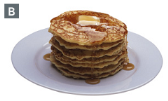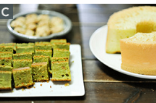Food customs around the world
LEARNING OUTCOMES:
■ to learn about food customs in other cultures and use what I learn to make connections with my own culture.
■ to discuss food customs in my own culture and understand my own cultural identity.
■ to make comparisons between cultures and use my own beliefs and values to improve my cultural knowledge.
Food customs around the world
VOCABULARY FOCUS
bagpipes [n]:a Scottish musical instrument consisting of a bag with several pipes sticking out of it. You play it by blowing air through one of the pipes.
custom [n]:tradition
dine [v]:to eat dinner
dough [n]:a mixture of flour, water, fat, yeast, etc that is used to make bread or pastry
feast [n]:a large meal
harvest [n]:the activity of collecting a crop
lobster [n]:a shellfish that has a long body, eight legs, and two large claws
native Americans [n]:the people who lived in North America before Europeans arrived
oil lamp [n]:an object that produces light by burning oil
Pilgrim [n]:one of the people who left England and went to live in the USA in the early 17th century
poem [n]:a piece of writing that uses language arranged in fixed lines that have a beat and often rhyme
poet [n]:a person who writes poems
previous [adj]:the one happening before the one you are talking about
prosperity [n]:having a lot of money
pudding [n]:a savoury dish containing (meat) and sometimes flour or pastry
pudding [n]:a soft sweet food that you eat at the end of a meal
pumpkin [n]:a large round vegetable with a thick orange skin
spices [n]:a substance made from plants that you add to a food to give it flavour
syrup [n]:a sweet liquid made from sugar and water
wealth [n]:having a lot of money
wrap [v]:to cover something by putting something around it
1 Look at the photos. Do you know the festivals and the foods? In which countries do you think people eat these foods on special occasions?



2a Read the information about some special occasion foods around the world. Match the photos to the correct countries.
Food customs around the world
Around the world, special foods are associated with special celebrations and occasions. These food customs have developed over the years for different traditional and cultural reasons. This article features four countries and explores how and why they celebrate their special occasions with food.
![]() SCOTLAND
SCOTLAND ![]()
Haggis is a food from Scotland in the UK. People traditionally eat it on 25th January. This is Burns Night, a special day to celebrate Robert Burns, the Scottish poet (1759-1796). Burns wrote a famous poem about haggis, and it is now the custom to eat it in celebration of him. Haggis is a meat pudding made of animal products that people began eating in Scotland hundreds of years ago. On Burns Night, a person playing the bagpipes, a traditional musical instrument, comes into the room and the haggis follows, carried high by a waiter ready for the people to eat. Scottish people who live in other countries enjoy this celebration, too and over the last four years the UK has sent £4.85 million worth of haggis to 28 different countries worldwide.
![]() INDIA
INDIA ![]()
Diwaliis the Hindu Festival of Light and it is in October each year. Eighty per cent of India’s population is Hindu so Diwali is a very big festival. It celebrates Lakshmi, the goddess of wealth and prosperity. People light hundreds of small oil lamps in their homes and gardens during the celebration. Food has an important role in this five-day festival, and women start preparing the food about a month before. It is the custom to make the food together as a social activity. One of the most popular foods at Diwali is sweets and sweet desserts. Gulab jamunis a favourite.
These are dough balls flavoured with sugar syrup and spices. They’re also very popular at other celebrations like weddings.
![]() USA
USA ![]()
Thanksgiving is the biggest festival in the USA. The first Thanksgiving celebration was in November 1621. The Pilgrims who arrived from England the previous year made a special feast of thanks for their very good harvest and they invited the native Americans to dine with them. The food they ate came from the sea and the land around them, including wild turkey, pumpkin, lobsters, fish and fruit. Today, turkey is one of the traditional foods that Americans eat each year for this celebration. About 46 million turkeys every Thanksgiving Day in fact
![]() CHINA
CHINA ![]()
Chinese New Year is a very important festival and Chinese people around the world celebrate it. Chinese New Year lasts for 16 days and, during this time, people eat special food that will bring good luck for the year ahead. Dumplings or jiaoziare one of the most popular Chinese New Year special foods. These are small balls made of meat and vegetables and wrapped in dough. They’re popular at this celebration because they look like the pieces of gold that the Chinese used for money hundreds of years ago, and a lot of families serve them at midnight on New Year’s Eve for prosperity.




2b Read the texts again and write the foods. Then match to the special occasions (a–d).
1 It’s made of animal parts. a Chinese New Year
2 It’s made of dough and is sweet to taste. b Burns Night
3 It’s meat from a type of bird. c Diwali
4 They have meat in them, and sometimes seafood and vegetables, too. d Thanksgiving
2c Read and match.
1 People in the USA eat turkey ………… a because they believe the food brings luck.
2 People in India eat sweet desserts ………… b to celebrate an important person from their country.
3 People in Scotland eat haggis ………… c and light up their homes for this festival.
4 People in China eat dumplings ………… d because it was the food served at a special dinner
almost 400 years ago.
2d Read and tick (✓) the correct festivals. More than one may be correct per answer.
|
|
|
Burns Night |
Diwali |
Thanksgiving |
Chinese New Year
|
|
1 |
1 It’s the longest festival. |
|
|
|
|
|
2 |
2 It’s celebrated on one day of the year only. |
|
|
|
|
|
3 |
3 It’s traditional to eat lots of sweet foods. |
|
|
|
|
|
4 |
It’s a celebration of thanks. |
|
|
|
|
|
5 |
Luck and prosperity are impor-tant reasons to celebrate these festivals. |
|
|
|
|
3a Work with a partner and discuss the questions.
1 What do people eat for celebrations and other special occasions in your country?
2 Why do you think these foods are associated with important events in your country?
3 Do you think it’s important to celebrate important events with traditional foods? How else are important events celebrated in your country?
PROJECT
3b You are going to make a poster illustrating the food customs of another country. Read the points and prepare your project research.
1 Work in small groups. Choose a country and research the foods that people traditionally eat for celebrations and other special occasions.
2 In your groups, prepare your poster using the information you have gathered. Illustrate it with drawings or photos of the foods and write a description of the special occasions using your research notes.
3c Present your poster to the rest of the class. Explain the food customs of the country and why they celebrate a festival or special occasion with these foods. Then display your poster in the classroom, and read the information from the other groups. Compare the food customs of the different countries with those of your own country.
The keys:
1. Possible answers
A Mid-autumn or Mooncake Festival = China, Vietnam (celebrates the harvest and the autumn full moon)
B Mardi Gras or Shrove Tuesday = many Christian countries around the world, e.g. France, UK, USA, Brazil (pancakes are traditionally eaten to celebrate the beginning of a fasting period)
C Eid al-Fitr = Muslim countries around the world (celebrates the end of the holy month of Ramadan where people enjoy a fabulous feast)
2a Scotland 3 India 4 USA 1 China 2
2b 1 haggis, b 2 gulab jamun, c 3 turkey, d 4 dumplings/jiaozi, a
2c 1 d 2 c 3 b 4 a
2d 1 Chinese New Year 2 Burns Night and Thanksgiving 3 Diwali 4 Thanksgiving 5 Diwali and Chinese New Year


про публікацію авторської розробки
Додати розробку
